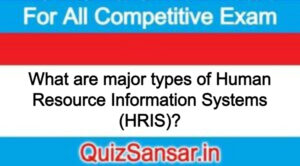
What are major types of Human Resource Information Systems (HRIS)?
What are major types of Human Resource Information Systems (HRIS)?
Ans.
There are different types of HRIS that every organization makes use of in order to carry out their daily tasks of managing employees. So what are these different types of HRIS? Here’s a look:
1. Operational HRIS
Operational HRIS is of immense help to the manager. It provides the manager with all the required data to support routine and repetitive human resource decisions. Many operational level human resource systems collect and report human resource data. These systems usually include information about the organization’s employees and position and also about governmental regulations. Two major sub-divisions under operational HRIS comprise the following:
1. Employee Information Systems: Employee information systems is a major part of operational HRIS. Organizations need to keep a track of an employee’s records and details pertaining to all kinds of personal and professional details including name, address, sex, minority status, citizenship, education, past professional experiences and much more.
2. Position Control Systems: The concept of position control systems is introduced in an organization in order to identify each position within the organization; the job title within which the position is classified; and the employee currently assigned to the position. Referring the position control systems, a HR manager can identify the details about and unfilled position.
3. Performance Management Information Systems : Performance Management Information Systems include performance appraisal data and productivity information data. This system is frequently used as an evidence in employee grievance matters. Careful documentation of employee performance and of how the performance was measured and reported in critical to acceptance of appraisal information in grievance hearing. Performance management systems can lead to a number of decisions beyond merely the decisions to retain, promote, transfer or terminate an employee.
II. Tactical HRIS
Tactical human resource information systems provide managers with support for decisions that emphasize the allocation of resources. Within the domain of HR, these include recruitment decisions, job analysis, and design decisions, training and development and also employee compensation plans. Tactical HRIS also has a few subparts that are explained below:
1. Job Analysis and Design Information System: The inputs to the job analysis and design information system, include data form supervisors and workers and affirmative action guidelines. Inputs also comprise information from external sources to the firm, such as labour unions, competitors and government agencies.
2. Recruiting Information Systems: In order to direct the recruiting function, the organization needs to develop a proper recruiting plan. The plan is designed in order to address gaps such as vacant positions to be filled and skills required for the employees for these positions. If this plan is to be executed, a proper recruiting information system is pretty much required, so that everything is executed with proper ease.
3. Compensation and Benefits Information Systems: This particular information systems may support a variety of tactical HR decisions, especially when it comes to compensation and benefits systems. Compensation and benefits plan an important role in the overall productivity of the organization.
4. Employee Training and Development systems: Another major aspect where HRIS is extensively implemented is the domain of employee training and development. The training must be directed at those individuals who are not only interested but also capable of benefiting from it.
III. Strategic HRIS
Strategic HRIS focuses on supporting labour negotiations, workforce planning, and certain specialized human resources software. The main purpose of this is to have an overall good idea about labour resources and workforce planning. Major types of strategic HRIS comprise the following:
1. Information Systems Supporting Workforce Planning: Organization that are involved in long-term strategic planning, such as those planning to expand into new market areas, construct factories or offices in new locations, or add new products, will need information about the quantity and quality of the available workforce to achieve their goals.
2. Specialized Human Resource Information Systems Software: There has been a great deal of software that has been designed for the proper functioning of the human resources. Software that is specifically designed for the human resource management function can be divided into two basic categories: comprehensive human resource information systems software and limited-function packages that support one or a few human resource activities.
IV. Comprehensive HRIS
The computerization of HRIS has resulted in an integrated database of human resource files, employee files, position, skills inventory files, affirmative action files, job analysis and design files, occupational health and safety files, and many other human resource files are constructed in a coordinated manner using database management systems software so that application programs can produce reports from any or all of the files.






